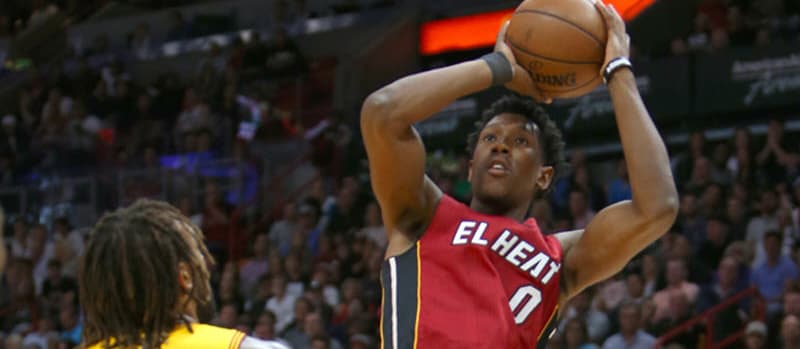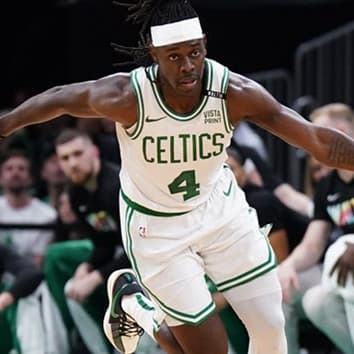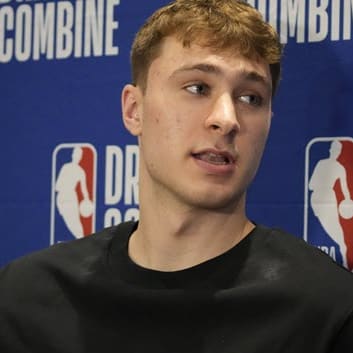This article is part of our Numbers Game series.
With the real NBA All-Star Game now in the rear-view, let's check in on which players would qualify for the fantasy All-Star team.
This is more than just an academic exercise. To be a Fantasy All-Star, you have to be a player who's exceeding expectations. In most leagues, the bounty or dearth of these players have determined which teams are great, and which are not.
As the Fantasy trade deadline approaches, it is crucial to understand which of these players are still undervalued (potential "buy lows") and which have seen their perception rise too high (potential "sell highs").
Guidelines
1. There are 18 Fantasy All-Stars: Why 18? Because standard Fantasy leagues have nine starters. An NBA game pitches 12 active players against 12 active players, so the NBA's All-Star Game features 24 players (12 + 12 = 24). A head-to-head fantasy matchup is a 9-on-9 affair (and 9 + 9 = 18).2. Conferences don't matter: They have no impact on Fantasy Basketball. In their place, we'll focus on category representation. Each of the nine standard categories needs at least one representative in the All-Star squad.
3. We're focusing on per-game production: Obviously you have to play to qualify. Patrick Beverley exceeded expectations, but he only played 11 games. This rule more so accounts for certain teams playing more games than others. The Timberwolves, for instance, get no advantage over the Clippers for having played six extra games.
What makes a Fantasy All-Star?
Fantasy All-Stars are the players that areWith the real NBA All-Star Game now in the rear-view, let's check in on which players would qualify for the fantasy All-Star team.
This is more than just an academic exercise. To be a Fantasy All-Star, you have to be a player who's exceeding expectations. In most leagues, the bounty or dearth of these players have determined which teams are great, and which are not.
As the Fantasy trade deadline approaches, it is crucial to understand which of these players are still undervalued (potential "buy lows") and which have seen their perception rise too high (potential "sell highs").
Guidelines
1. There are 18 Fantasy All-Stars: Why 18? Because standard Fantasy leagues have nine starters. An NBA game pitches 12 active players against 12 active players, so the NBA's All-Star Game features 24 players (12 + 12 = 24). A head-to-head fantasy matchup is a 9-on-9 affair (and 9 + 9 = 18).2. Conferences don't matter: They have no impact on Fantasy Basketball. In their place, we'll focus on category representation. Each of the nine standard categories needs at least one representative in the All-Star squad.
3. We're focusing on per-game production: Obviously you have to play to qualify. Patrick Beverley exceeded expectations, but he only played 11 games. This rule more so accounts for certain teams playing more games than others. The Timberwolves, for instance, get no advantage over the Clippers for having played six extra games.
What makes a Fantasy All-Star?
Fantasy All-Stars are the players that are the reason their rosters are winning.Fantasy All-Stars are not a simple list of the top-18 players. If you want that, you don't need an article, you just need this link.
To be a Fantasy All-Star, you have to outperform your draft spot (measured by Average Draft Position, or ADP). If a Fantasy manager regrets picking someone, then the player in question is not an All-Star. Period.
The only exception to that rule is for players frequently used to punt a specific category. For example, drafters usually know that they are punting turnovers when they pick Russell Westbrook, or that they are punting free throws when they pick DeAndre Jordan. Those players will be included or excluded according to their value to a punting team.
(Ok, technically there is one other possible exception to this rule, but no one qualifies for it this year so it doesn't matter. For more, check here.)
2017-18 Fantasy All-Stars
PG: Donovan Mitchell, Jazz: The surprising Rookie of the Year contender went mostly undrafted in October. After two weeks of unspectacular play, he exploded, becoming probably the most important waiver wire pickup of the season. He's been a top-55 player on the year, and Lou Williams is the only player averaging more points per game than Mitchell with an ADP outside the top-55. Williams' ADP was 83. Mitchell's was 179.PG: Tyreke Evans, Grizzlies: Part of Evans' appeal is his availability across three different positions. He registers as a point guard here because it's his work as the Grizzlies' starting PG that earned this spot. Drafted outside the top-100, he's more than rebounded from his down 2016-17 campaign in Sacramento. He's adding value in five categories and posting career-best numbers in two more.
SG: Victor Oladipo, Pacers: I keep expecting Oladipo to fall outside Fantasy's top-10, but it's been four and a half months and he's still there. He's posting career-best marks in seven of nine categories, and he's second in the league in steals per game. Added bonus: the Pacers have one of the most favorable Fantasy schedules over the remainder of the season.
SG: Lou Williams, Clippers: The 2016-17 Sixth Man of the Year candidate seemed positioned for a step back in LA. He'd have to fight for minutes in the crowded Clippers' backcourt, and the surrounding talent was noticeably worse. But Williams emerged as a borderline All-Star, and one of the rare players to have the best season of their career after age 30 (he's 31). He's emerged as a top-five player in free throw impact – and the other members of the top-five are players who've been there before.
SF: Gary Harris, Nuggets: Harris' ADP was a comically low 93 – a silly ranking considering he finished 2016-17 on the cusp of Fantasy's top-55. However, even in "expert" leagues, I don't remember ever seeing him drafted inside the top-40. Nonetheless, he has continued to improve, ranking firmly inside the top-35 despite a recent mini-slump. He was inside the top-25 at the start of February, and look for him to return to that peak as the Nuggets fight in the hyper-competitive Western conference playoff race.
SF: Josh Richardson, Heat: Richardson was pegged by many as a preseason sleeper. From October 25 to November 26, he was one of the biggest Fantasy disappointments, ranking outside the top-250. Since November 26, however, he's been a top-25 producer and a rare 1-1-1 (threes-steals-blocks) guy. Over that span, he's shot 48.9 percent from the field on 12.2 attempts per game – excellent numbers for a small forward also providing nearly two threes per game. If you held on, or if you picked him up after someone else lost patience, you've been handsomely rewarded.
PF: Lauri Markkanen, Bulls: Rookies are rarely productive Fantasy draft picks, but no one told that to Markkanen or the Bulls. Since day one, he's been scoring, rebounding, and making threes. He's had a pair of bad games here or there, but he's yet to hit the dreaded "rookie wall". He was typically drafted as a late-round flier, if he was drafted at all. Nonetheless, Markkanen's overall production has been only worse than that of Ben Simmons and Donovan Mitchell. He's outpaced the rest of this rookie class, including highly drafted names like Lonzo Ball and Dennis Smith, Jr.
PF: LaMarcus Aldridge, Spurs: Aldridge's draft stock took a hit during the 2017 Playoffs. However, with Kawhi Leonard (quad) sidelined for most of the season, Aldridge has looked more like a six-time All-Star than a playoff afterthought. He's providing solid second-round Fantasy value at a fifth-round price.
C: Anthony Davis, Pelicans: Davis probably would have made this list had DeMarcus Cousins (Achilles) never got hurt, but his insane post-Boogie numbers clinched his status. Davis is averaging 33.9 points, 13.2 rebounds, 2.6 blocks and 2.3 steals while shooting 50.0 percent from the floor in 12 games without Cousins. Over the course of the season, that would be first in points, blocks and steals, and third in rebounds. This man is on an insane tear. (Note, I'd consider "selling high", since it's really hard to sustain production this incredible).
C: Andre Drummond, Pistons: Managers drafting Drummond expected great rebounding, but no one expected the best non-Dennis Rodman season of the past 40 years. That's right, over the past 40 seasons, only Rodman has averaged more than Drummond's current 15.7 per game (sidenote: Rodman was crazy good; he topped 15.7 five times). Drummond's free throw shooting, though still atrocious, is finally mediocre enough that two great free throw shooters can overcome his misery. And, despite managers expecting his free-throw percentage to guarantee that his statistical value is lower than his ADP, Drummond has actually exceeded his ADP by nearly a full round.
G: James Harden, Rockets: All summer, Fantasy analysts (myself included) kept talking about how crowded the top of Fantasy drafts was. Eight players were discussed as reasonable selections at number one overall, and three-to-five more were nipping at the top-eight's heels. Safely navigating that crowded market and emerging with a top-two player is a massive win, even if Harden's ADP and his current ranking are effectively identical. Rosters are better if they feature a top-four player, and all managers who came out of the first round without Kawhi Leonard or John Wall ought to feel good.
G: Steph Curry, Warriors: Everything said about Harden above applies to Curry (as well as Kevin Durant -- see below). Curry deserves some credit for hitting 30 years old without suffering a meaningful decline in any category.
F: Kevin Durant, Warriors: As with Harden and Curry, above, Durant would qualify for this list simply based on his current top-four status after last summer's draft preparations left managers with more high-end choices than usual. But Durant gets extra credit for his emergence as an elite shot-blocker. The small forward's 1.9 blocks per game is by far the most of his career and is good for fifth in the league. Managers knew to expect some block help from Durant, but they weren't expecting him to out-pace Joel Embiid, Hassan Whiteside and DeAndre Jordan.
F: Taj Gibson, Timberwolves: It was easy to predict that the Timberwolves' starting power forward would be roughly a top-60-ish Fantasy producer. Gorgui Dieng had been just that for each of the past three seasons. But many, myself included, expected Dieng to keep that job. That's why Dieng's ADP was 73, while Gibson's was 139.
UTIL: Otto Porter, Wizards: It is quite difficult to be a great Fantasy player and not hurt your team in turnovers. Porter and Trevor Ariza are the only two players inside the top-65 averaging less than one turnover per game. Not only is Porter a significantly better Fantasy option than Ariza, but Porter also beats his own ADP by much more than Ariza did.
UTIL: LeBron James, Cavaliers: At 32 years old, James is setting his career high in assists. Needless to say, not many of us saw that coming. The fact that he's third in the league in that category makes the accomplishment even more impressive. Add to that his return to Fantasy's top-10 after a one-year sabbatical, and James is a worthy Fantasy All-Star.
UTIL: J.J. Redick, 76ers: It's not really a surprise to anyone that Redick can make 2.7 threes per game – in fact, he's averaged at least 2.6 in each of the past three seasons. But among the league's elite three-point shooters, Redick is the one who has provided the most significant value above his ADP. With an ADP of 130, Redick has provided consistent, top-70 value.
UTIL: Clint Capela, Rockets: The Rockets' big man has exceeded even the most optimistic expectations, and he's doing it despite averaging only 27.3 minutes per game. He leads the league in field goal impact, and is sixth in blocks.










